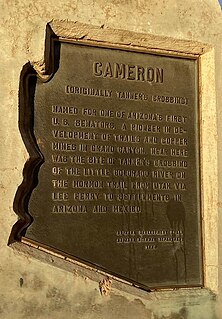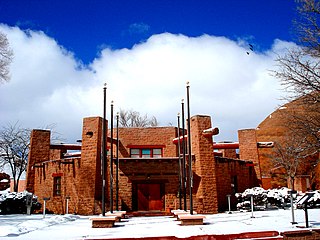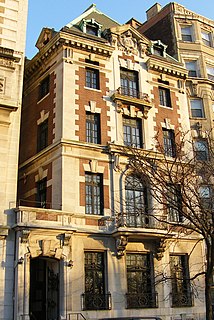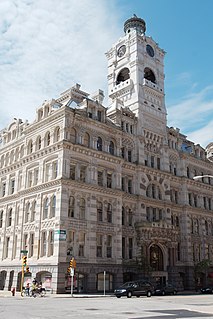
Cameron is a census-designated place (CDP) in Coconino County, Arizona, United States, on the Navajo Nation. The population was 885 at the 2010 census. Most of the town's economy is tourist food and craft stalls, restaurants, and other services for north–south traffic from Flagstaff and Page. There is a ranger station supplying information and hiking permits for the Navajo Nation as well as a small selection of books for sale. There is also a large craft store run by the Nation itself; most vendors in the area operate from small private stalls. It is named after Ralph H. Cameron, Arizona's first senator.

Hubbell Trading Post National Historic Site is a historic site on Highway 191, north of Chambers, with an exhibit center in Ganado, Arizona. It is considered a meeting ground of two cultures between the Navajo and the settlers who came to the area to trade.

Navajo Nation Council Chamber is the center of government for the Navajo Nation. The landmark building, in Window Rock, Arizona, is significant for its association with the 1930s New Deal, and its change in Federal policy for relations with Native Americans, as established in the Indian Reorganization Act. With its red sandstone façade and overall rustic architectural style, the chamber was designed to harmonize with its spectacular natural surroundings. The building was declared a National Historic Landmark in 2004. It is "the only legislative headquarters in the United States owned by an American Indian tribe which has been continuously in use by that tribe and whose design incorporates indigenous materials and architectural traditions tied to the Navajo heritage."

The Astor Fur Warehouse is a historic fur warehouse located at Bolvin and Water Streets on St. Feriole Island in Prairie du Chien, Wisconsin. Jean Joseph Rolette, an agent of the American Fur Company, built the warehouse in 1828. The warehouse was used until the mid-19th century; it has since been incorporated into the Villa Louis museum. The building, now a National Historic Landmark, is the only known surviving fur trade warehouse in the upper Mississippi valley.

The Robert C. McEwen United States Custom House, also known as U.S. Customshouse, is a historic customshouse building located at Ogdensburg in St. Lawrence County, New York. It was built in 1809-1810 as a store and warehouse. It is a two-story, utilitarian, gable roofed, stone bearing wall structure approximately 60 feet wide and 120 feet long. The Federal government purchased it in 1936 and converted it for use as a customshouse. It is the oldest within the building inventory of the General Services Administration.
St. Paul's Church is a historic Episcopal church located at Brownville in Jefferson County, New York. It was built about 1820 and is a two-story, timber-framed church built of native limestone coated in stucco and exhibiting characteristics of Federal-style church architecture. It features a prominent steeple that consists of a square base and a three-stage octagonal spire.

The Delta Psi, Alpha Chapter fraternity house is located at 434 Riverside Drive in the Morningside Heights neighborhood of Manhattan, New York City. It was purpose built in 1898 and continues to serve the Columbia Chapter of the Fraternity of Delta Psi, a social and literary fraternity.

St. Mary's Catholic Church, known as the "Prairie Cathedral" or the "Cathedral of the Cornfields", is a Roman Catholic church in Beaverville, Illinois. The Romanesque Revival church was built in 1909–1911. The church features two towers and a tiled dome roof; it is both the tallest and most prominent landmark in Beaverville. In 1996, the church was added to the National Register of Historic Places.

The Bradford Community Church, originally the Henry M. Simmons Memorial Church and later the Boys and Girls Library, is a historic church built in 1907 in Kenosha, Wisconsin, United States under the leadership of Kenosha's first woman pastor.

The Mackie Building is a grand commercial building designed by E. Townsend Mix and built in 1879 in Milwaukee, Wisconsin, which housed Milwaukee's Grain Exchange Room, and the original trading pit. In 1973 the building was added to the National Register of Historic Places.

Bowlin's Old Crater Trading Post is a former trading post which was located along historic U.S. Route 66 in Bluewater, New Mexico. The trading post was built in 1954 by Claude Bowlin. Bowlin had traded with local Navajo since 1912, and he built his first trading post at the site in 1936. The store's name came from a volcanic crater that drew tourists to the area. While the trading post initially served the Navajo, it soon served tourists as well due to increased traffic on Route 66. Inspired by his success, Bowlin built a chain of stores throughout New Mexico, which became Bowlin Travel Centers, Inc. In 1954, Bowlin replaced his original trading post with the current building.

The Lawrence County Courthouse, located at 1100 State St. in Lawrenceville, is the county courthouse serving Lawrence County, Illinois. Built in 1888–89, the courthouse is the third used by the county; all three courthouses were built at the same site in Lawrenceville's public square. The McDonald Brothers, an architectural firm from Louisville, Kentucky, designed the building in the Renaissance Revival style. The courthouse has a six-story clock tower with a clock and bell made by the Seth Thomas Clock Company; the tower is topped by an octagonal copper cupola. The main entrance to the courthouse, located below the clock tower on the building's north side, is surrounded by a stone portico supported by Tuscan columns and topped by a balcony. A copper cornice and limestone architrave encircle the top of the courthouse's main section; the second-story windows of this section have copper architraves, and a limestone belt course separates the two stories.
Christian and Katharina Herschler House, Barn, and Outbuildings Historic District are historic buildings located in Franklin, Iowa, United States. The historic district, now known as the Christian Herschler Winery, is located on the edge of town. It was listed on the National Register of Historic Places in 1996. At the time of its nomination it included three contributing buildings: the house (1865), barn (1865) and a shed/summer kitchen. It also includes two noncontributing buildings: a two-room brick structure and a cement foundation. The Herschlers raised their own grapes and operated the town's only winery.

Canton School is a historic one-room schoolhouse located in the unincorporated community of Canton, Iowa, United States. This school building was built in 1877 of locally quarried, roughly-dressed limestone, laid in a random ashlar pattern. The main facade, however, is faced with concrete brick that is original to the structure. What is unusual about this building is its decorative elements, as most one-room schoolhouses built in Iowa were plain. The eaves and the two-stage wooden bell tower are edged with rather delicate wooden trim, and the windows are capped with concrete keystone hoods. The use of concrete is rather sophisticated for a building in the vernacular-folk architectural style in stone. The building served as a school until 1966 when the area's school districts were reorganized. It served as a church until 1968, and it is now surrounded by a park.

The William R. and Martha Foster Shriver House is a historic residence located in Winterset, Iowa, United States. William R. Shriver was an Ohio native who settled in Jefferson County, Iowa before he moved to Madison County in 1853–54. He married Martha Foster in 1858 in Winterset. He was a wagon-maker by trade, and served as a lieutenant in the 1st Iowa Cavalry during the American Civil War. Shriver went into farming in the 1870s, and they left this house at that time. He went on to serve as the Clerk of District Court from 1882 to 1887. The Shrivers left Iowa for California in 1890 because of Martha's health. She died there that same year, and William returned to Iowa permanently in 1900.

The Grand Isle County Courthouse is located at 3677 United States Route 2 in the center of North Hero, the county seat of Grand Isle County, Vermont. Built in 1824, it is one of the oldest surviving courthouses in the state, and the only surviving one built out of stone. It was listed on the National Register of Historic Places in 1996.

Haberkorn House and Farmstead is a historic farm located west of Sherrill, Iowa, United States. The farmstead features a good example of a vernacular house type that is found only in northeast Iowa within the state. Its more prominent in around the village of St. Donatus in Jackson County. The basic features of the house are rockfaced limestone construction, a jerkinhead gable roof, a rectangular plan, and two or more stories in height. This 2½-story structure differs a little in that it has a front gable rather than a side gable, and it is a little larger than the others. These houses were built by immigrants who came here from Luxembourg and southern Germany. Adam Haberkorn and his son George built this house in 1870, and were natives of Bavaria. The family operated a small brewery and the front room of this house became a local tavern, and a polling place in the late 19th century.

St. Michael's Mission, the first permanent Catholic mission to the Navajo, was established in 1898. A school was opened in 1902.

The Krenz-Kerley Trading Post, in Tuba City, Arizona, was built in 1915. It was listed on the National Register of Historic Places in 1998.


















